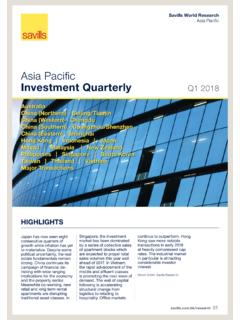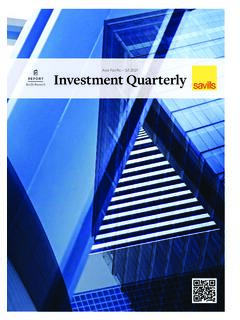Transcription of Spotlight Japan logistics April 2018 - pdf.savills.asia
1 Spotlight Japan logisticsApril 2018 Savills World Research 02 April 2018 Spotlight | Japan logistics The logistics industry continues to expand along with the steady growth of e-commerce. Large supply in Greater Osaka led to a signifi cant divergence with the Greater Tokyo market in 2017; however, supply will rebalance to Tokyo in 2018 and beyond. Against this backdrop, a divergence of local demand within the Tokyo and Osaka markets is becoming more pronounced. IntroductionJapan s logistics industry is undergoing rapid development and structural change in order to meet increasing demand. As modern logistics facilities continue to sprout up across the country, developers are emphasising convenience and comfort for employees in their design concepts given the acute labour shortage.
2 2017 also saw a signifi cant strategic rebalancing in the domestic shipping industry, as major fi rms made unprecedented moves to improve effi ciency and retain investment volumes in the logistics sector declined substantially in 2017, J-REITs announced JPY289 billion of acquisitions during the December 2017 to February 2018 period, all of which are set to be completed in early 2018. Market player sentiment has improved over 2H/2017, with expectations for rent and capital appreciation at their highest level since 1H/2016 and 2H/2016, respectively. Despite these positive indicators, the current supply glut in Greater Osaka and large supply in the pipeline for Tokyo are cause for concern. Demand for logistics space should be bolstered by the continuing expansion of the shipping industry and e-commerce, as well as the stable growth of the Japanese economy as a whole.
3 However, an increasingly uneven distribution of demand will require investors to be more selective than ever. SpotlightJapan logisticsSpotlight Japan logisticsApril 2018 Savills World Research Investors have come out swinging around the start of 2018, as multiple J-REITs announced acquisitions in the logistics sector totaling JPY289 billion, already exceeding total sector investment for 2017. Greater Osaka took centre stage for new supply in 2017, with million sq m of completions compared to Tokyo s million. 2018, however, is expected to see a major supply shift back to Tokyo. A percentage points (ppts) decrease in vacancy rates in Greater Tokyo in Q4/2017 should provide some stability for rent in 1H/2018. While a signifi cant increase in new supply may mitigate the effect, pre-leasing activity for logistics space in Greater Tokyo, particularly for locations inside the National Route 16 belt, appears smooth.
4 After three consecutive quarters of decline, rents in Greater Osaka saw a slight uptick and held steady at Q1/2017 levels. Vacancy rates rose a sharp year-over-year, but levelled out during Q4/2017. A cooling of supply in the region should continue to help rent and vacancy rates recover. Though 2016 and 2017 saw record-high demand for logistics space, the Tokyo and Osaka markets are experiencing a localised disparity in demand. Tokyo central and Osaka inland locations with convenient access to residential areas have seen increased interest, while locations outside of major infrastructure networks and population centres remain less competitive. Investor sentiment indicates a moderate turnaround as the diffusion index of responses to a survey of market players currently sits at + for expectations of capital appreciation, a point increase over the July 2017 survey, while expectations of further rental growth improved from to points.
5 Major logistics fi rms continue to increase revenue and the sector has recently seen signifi cant wage growth, which in turn should attract - or at least help retain - workers. SUMMARYM arket trendsThe Greater Tokyo and Osaka markets diverged signifi cantly in 2017. Demand for logistics space increased rapidly in the Greater Tokyo area towards the 2017 year end, as vacancy rates dropped during the period from November 2017 to January 2018 (Q4/2017). In Osaka, though there was a slight downtick in vacancy rates toward the year end, from a peak of in October 2017 (Q3/2017) to in Q4/2017, vacancy rates have increased a startling year-on-year (YoY). Overall demand in 2016 and 2017 reached record levels, largely driven by third-party logistics (3PL) and e-commerce fi rms.
6 While overall demand is expected to increase at a similar rate over the next few years, both major markets are experiencing an uneven geographic distribution of tenant interest. In Greater Tokyo, bayside and inland properties within the National Route 16 belt continue to attract tenants, while locations outside of population centres with less convenient access have seen less interest. Similarly, inland Greater Osaka properties remain relatively popular, especially those near junctions of major thoroughfares. This disparity has led properties in prime locations to have rent and capital appreciation higher than the overall area average, with less competitive properties moving in the opposite 03 Spotlight | Japan logisticsGRAPH 3 Supply, take-up, and vacancy in Greater Osaka, 2010 2H/2017 Note: Annual periods from February to January.
7 Source: Ichigo Real Estate Service, Savills Research and ,0001,1251,2501,375201020112012201320142 01520162017 Vacancy rateThousand sq mCompletionsNet absorption5Y avg completions (2013-2017)Vacancy rate (RHS)While rent per tsubo in Greater Tokyo is largely unchanged compared to the end of 1H/2017, vacancy rates are down over Q4/2016 as net absorption exceeded completions in 2H/2017. According to Ichigo Real Estate Service, 553,000 sq m of new supply was added to the Tokyo market in 2H/2017. Net absorption spiked to 463,000 sq m in Q4/2017, an increase of more than 100% quarter-on-quarter (QoQ), exceeding new supply by 163,000 sq m. Despite the year-end boost in demand in the Tokyo market, however, asking rent declined slightly from the Q3/2017 high of JPY4,280, to JPY4,200 per tsubo per month as of the end of Q4, an increase of only YoY.
8 Though certain inland properties in prime locations are seeing smooth leasing activity, inland areas with a high concentration of development have seen less demand overall than better-located properties. The expectation of a large amount of inland supply in 2018 is likely to make this divergence more pronounced. In the long-term, infrastructure developments such as the expansion of the Ken-O Expressway should facilitate supply weighed heavily on the Greater Osaka market in 2017, though year-end trends indicate a potential recovery. According to Ichigo Real Estate Service, 688,000 sq m of new supply was added in the August to October 2017 period (Q3/2017), exceeding net absorption by 200,000 sq m. Supply cooled substantially during Q4/2017, as only 75,000 sq m of space was added, which was matched by net absorption.
9 Based on disclosed information, new supply in the Greater Osaka market will cool down to some extent after 1H/2018, which should help reduce vacancies over asking rent YoY dropped , to JPY3,350 per tsubo per month, and remained fl at QoQ. Rental prices reached a low of JPY3,310 in Q2/2017, a decline over Q3/2016; however, rents appear to have levelled off towards the year end, with Q4/2017 seeing a slight increase of over Q2/2017. Vacancies also appear to have levelled off as of the year growth in Osaka should stabilise over time as the development GRAPH 2 Greater Tokyo rent vs. vacancy, Q1/2016 Q4/2017 Note: Annual periods from February to January. Source: Ichigo Real Estate Service, Savills Research and ,8003,8503,9003,9504,0004,0504,1004,1504 ,2004,2504,300Q1Q2Q3Q4Q1Q2Q3Q420162017 Vacancy rateJPY / tsubo / monthAverage rent (LHS)Average vacancy (RHS)GRAPH 1 Supply, take-up, and vacancy in Greater Tokyo, 2010 2H/2017 Note: Annual periods from February to January.
10 Source: Ichigo Real Estate Service, Savills Research and ,0001,5002,00020102011201220132014201520 162017 Vacancy rateThousand sq mCompletionsNet absorption5Y avg completions (2013-2017)Vacancy rate (RHS) April 04 Spotlight | Japan logisticsGRAPH 5 Six-month-ahead expectations for rent and capital appreciation, 2008 1H/2018 Note: Index is calculated as the number of responses saying rents/values will increase minus the number of responses saying rents/values will decrease. Source: Ichigo Real Estate Service, Savills Research and 2009 2010 2011 2012 2013 2014 2015 2016 2017 18 Diffusion indexRentsCapital valuespipeline subsides. In the long term, the continuing development of major highways such as the Shin-Meishin Expressway and the Osaka Urban Regeneration Loop should have a positive impact on the supplyBased on public disclosures, over million sq m of supply will be added to the Japanese market in 2018 (February 2018 - January 2019), over million sq m of which will be supplied to the Greater Tokyo market, with over 800,000 sq m set to enter the Greater Osaka market.










